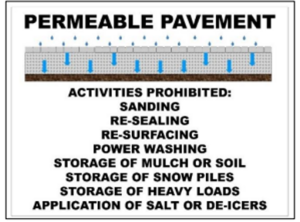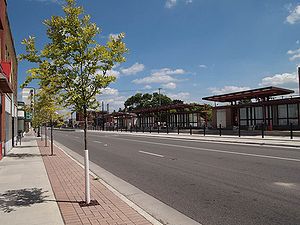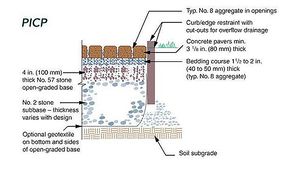
Difference between revisions of "Green Infrastructure benefits of permeable pavement"
m (→References) |
|||
| Line 86: | Line 86: | ||
*Habitat improvement: Permeable pavement has minimal benefit for habitat but can be combined with vegetated practices. See habitat benefits for [https://stormwater.pca.state.mn.us/index.php?title=Green_Infrastructure_benefits_of_bioretention bioretention], [https://stormwater.pca.state.mn.us/index.php?title=Green_Infrastructure_benefits_of_tree_trenches_and_tree_boxes tree trenches], and [https://stormwater.pca.state.mn.us/index.php?title=Green_Infrastructure_benefits_of_vegetated_swales swales]. | *Habitat improvement: Permeable pavement has minimal benefit for habitat but can be combined with vegetated practices. See habitat benefits for [https://stormwater.pca.state.mn.us/index.php?title=Green_Infrastructure_benefits_of_bioretention bioretention], [https://stormwater.pca.state.mn.us/index.php?title=Green_Infrastructure_benefits_of_tree_trenches_and_tree_boxes tree trenches], and [https://stormwater.pca.state.mn.us/index.php?title=Green_Infrastructure_benefits_of_vegetated_swales swales]. | ||
*Community livability: | *Community livability: | ||
| − | **When appropriate and feasible, incorporate vegetated practices or harvest and reuse systems into the design to improve aesthetics and provide additional water quality and quantity benefits. | + | **When appropriate and feasible, incorporate vegetated practices or harvest and reuse systems (see Beechem et al., 2010) into the design to improve aesthetics and provide additional water quality and quantity benefits. |
**Incorporation of vegetation promotes mental health | **Incorporation of vegetation promotes mental health | ||
*Health benefits: | *Health benefits: | ||
Revision as of 17:33, 15 November 2022
Permeable pavement is a stormwater management technology beneficial for long term soil and water preservation. It has significant water quality impact for downstream receiving waters such as lakes, rivers, and ponds. Permeable pavement allows water to infiltrate quickly through the porous pavement and underlying media. As it infiltrates this water is filtered before passing into the ground underneath or to an underdrain.
When designing a system, it is recommended to determine if permeable pavement would be feasible. This design consideration allows a site to benefit by changing the pervious to impervious surface ratios on a location. Permeable pavement can be used in conjunction with other stormwater measures to ensure maximum benefit. Examples include
- permeable pavement built with underground cisterns, vaults, or other treatment devices;
- permeable pavement used with harvest and reuse systems for irrigation;
- increased vegetation options at a site due to increased groundwater accessibility; and
- systems in which other infiltration methods are difficult to achieve or may cause detrimental effects.
Different types of permeable pavement include
- interlocking pavers,
- pervious concrete,
- porous asphalt, and
- plastic grid pavers
Permeable pavement can also be used to increase the safety of a site as it has been shown to increase traction and prevent ice accumulation on roadways during adverse weather. (USGS)
For more information on how permeable pavements work please click here.
Contents
Green infrastructure and multiple benefits
Green infrastructure and multiple benefits
Green infrastructure (GI) encompasses a wide array of practices, including stormwater management. Green stormwater infrastructure (GSI) encompasses a variety of practices primarily designed for managing stormwater runoff but that provide additional benefits such as habitat or aesthetic value.
There is no universal definition of GI or GSI (link here fore more information). Consequently, the terms are often interchanged, leading to confusion and misinterpretation. GSI practices are designed to function as stormwater practices first (e.g. flood control, treatment of runoff, volume control), but they can provide additional benefits. Though designed for stormwater function, GSI practices, where appropriate, should be designed to deliver multiple benefits (often termed "multiple stacked benefits". For more information on green infrastructure, ecosystem services, and sustainability, link to Multiple benefits of green infrastructure and role of green infrastructure in sustainability and ecosystem services.
| Benefit | Effectiveness | Notes |
|---|---|---|
| Water quality | Benefits are maximized for bioinfiltration. Biofiltration may export phosphorus if not designed properly. | |
| Water quantity/supply | Bioinfiltration helps mimic natural hydrology. Some rate control benefit. | |
| Energy savings | ||
| Climate resiliency | Provides some rate control. Impacts on carbon sequestration are uncertain. | |
| Air quality | ||
| Habitat improvement | Use of perennial vegetation and certain media mixes promote invertebrate communities. | |
| Community livability | Aesthetically pleasing and can be incorporated into a wide range of land use settings. | |
| Health benefits | ||
| Economic savings | Generally provide cost savings vs. conventional practices over the life of the practice. | |
| Macroscale benefits | Individual bioretention practices are typically microscale, but multiple bioretention practices, when incorporated into a landscape design, provide macroscale benefits such as wildlife corridors. | |
| Level of benefit: ◯ - none; ◔; - small; ◑ - moderate; ◕ - large; ● - very high | ||
Green Infrastructure benefits of infiltration practices
- Water quality: Pollutants are removed through stormwater runoff reduction via infiltration. Permeable pavements are very effective infiltration practices though they typically are small in size and require frequent maintenance.
- Water quantity and hydrology: Permeable pavement provides reduction in total water volume movement and retardation of peak flow from rainfall events. Helps protect from downstream flooding and can be used in conjunction with reuse systems to reduce required water consumption for onsite irrigation. Infiltration also recharges local groundwater.
- Energy: Though permeable pavements are typically energy intensive during the construction phase, life cycle cost studies suggest they can provide energy savings once built. These savings are associated with reduced requirements for treatment, water savings, reduced snow and ice maintenance. Permeable pavements can also be combined with other energy saving practices, such as harvest and reuse, and with energy supply practices, such as ground source heat pumps (Antunes et al., 2018; Coupe et al., 2009; Hui et al., 2020; Imran et al., 2013; Wang et al., 2018).
- Air quality: In areas adjacent to permeable pavements, reduced use of deicers decreases salt dispersion via air pathways. Permeable pavements may result in lower air emissions associated with traffic and snow clearing equipment.
- Climate resiliency: Helps alleviate the impact on flooding for small- and medium-intensity storms and runoff events. Saves water when combined with reuse systems.
- Habitat improvement: Permeable pavement provides minimal habitat benefit, but can be combined with vegetative systems. Reduction in water temperature changes as a result of volume flow reduction.
- Community livability: Well designed permeable pavement practices helps to protect recreation sites for people by ensuring safe and healthy access to water sources. Permeable pavements can be aesthetically pleasing and provide safety features compared to traditional pavements (US EPA).
- Health benefits: Water quality benefits associated with reduction of nutrients, pathogens, metals, TSS, and phosphorus via infiltration. Provides improved safety features compared to traditional pavements by infiltrating water quickly through the pavement, less pooling of water, and reduced ice formation. Minimizes mosquito breeding by avoiding standing water on site.
- Economic savings: In addition to water quality and flood control benefits, properly installed permeable pavers can prevent downstream cleanup needs. Permeable pavement can increase property aesthetics that increase property value, particularly when combined with vegetated systems.
Design considerations
Maximizing specific green infrastructure (GI) benefits of constructed areas requires design considerations prior to installation. While site limitations cannot always be overcome, the following recommendations are given to maximize the GI benefit.


- Water quality and water quantity/hydrology: These benefits are combined since permeable pavement design focuses on infiltration, with the subsoil having less impact on pollutant retention compared to other infiltration practices such as bioinfiltration, where organic matter can be incorporated into the design.
- Ensure the subgrade is flat. Since roads are typically sloped, utilize terracing in the subgrade to achieve flat slopes. See page 5 of the North Carolina design guidance.
- Incorporate signage into the design to ensure maintenance activities do not affect the infiltration properties of the pavement.
- Design to maximize retention time and prevent short-circuiting. Storage may be increased by use of geotextile subgrades. An example is presented by Nnadi et al, (2014).
- Plan for the expected loading on the permeable pavement and ensure capabilities and reduce compaction or clogging
- Use in conjunction with other treatments to establish a treatment train or reuse water on site
- Some research has been conducted into use of geotextiles and other amendments for enhancing water quality treatment. See Ostrom and Davis (2019) and Nnadi et al. (2014).
- Climate resiliency:
- Established systems using permeable pavement reduces the runoff impact on surrounding waterways through decreased pollutant loads and increased infiltration
- Permeable pavement systems can be established to support vegetation through water reuse systems, promoting further enhancement of water
- Habitat improvement: Permeable pavement has minimal benefit for habitat but can be combined with vegetated practices. See habitat benefits for bioretention, tree trenches, and swales.
- Community livability:
- When appropriate and feasible, incorporate vegetated practices or harvest and reuse systems (see Beechem et al., 2010) into the design to improve aesthetics and provide additional water quality and quantity benefits.
- Incorporation of vegetation promotes mental health
- Health benefits:
- Safety of community is improved by water infiltrating quickly through the pavement, less pooling of water, and reduced ice formation
- Minimizes mosquito breeding by avoiding standing water on site
- Economic benefits and savings:
- Reduction in maintenance cost for vegetation if water reuse system is used in conjunction with permeable pavement
- Reduction in land space required as the pervious area can serve a dual purpose for cement and treatment that would otherwise be ineligible for water quality volume treatment
- Integrates infiltration into landscape design, including creating habitat, pathways, picnic areas, etc.
Recommended reading
- A Systematic Review of the Hydrological, Environmental and Durability Performance of Permeable Pavement Systems - Sambito et al., Sustainability, 13(8), 4509; https://doi.org/10.3390/su13084509
References
- Antunes, L.N., E. Ghisi, and L.P. Thives. 2018. Permeable Pavements Life Cycle Assessment: A Literature Review. Water 2018, 10(11), 1575; https://doi.org/10.3390/w10111575.
- Beecham, S., T. Lucke, and B. Myers. 2010. Designing Porous and Permeable Pavements for Stormwater Harvesting and Reuse. Conference: 1st European International Association for Hydro-Environment Engineering and Research (IAHR) ConferenceAt: Edinburgh.
- Coupe, S. J., S. Charlesworth, and A.S. Faraj. 2009. COMBINING PERMEABLE PAVING WITH RENEWABLE ENERGY DEVICES: INSTALLATION, PERFORMANCE AND FUTURE PROSPECTS. 9th. International Conference on Concrete Block Paving. Buenos Aires, Argentina, 2009/10/18-21 Argentinean Concrete Block Association (AABH) - Argentinean Portland Cement Institute (ICPA) Small Element Paving Technologists (SEPT).
- Hui, J.L., L.Y. Wang, and H. Zhang. 2020. Integrated life cycle assessment of permeable pavement: Model development and case study. Transportation Research Part D: Transport and Environment Volume 85, 102381. https://doi.org/10.1016/j.trd.2020.102381.
- Imran, H.M., S. Akib, M.R. Karim. 2013. Permeable pavement and stormwater management systems: a review. Environmental Technology, Volume 34, Issue 18. https://doi.org/10.1080/09593330.2013.782573.
- Nnadi, E.O., S.J. Coupe, L.A. Sañudo-Fontaneda, and J. Rodriguez-Hernandez. 2014. An evaluation of enhanced geotextile layer in permeable pavement to improve stormwater infiltration and attenuation. International Journal of Pavement Engineering, Volume 15, - Issue 10.
- North Carolina Department of Environmental Quality. 2017. NCDEQ Stormwater Design Manual; C-5 - permeable pavement.
- Ostrom, T.K., A.P. Davis. 2019. Evaluation of an enhanced treatment media and permeable pavement base to remove stormwater nitrogen, phosphorus, and metals under simulated rainfall. Water Research, Volume 166, 115071. https://doi.org/10.1016/j.watres.2019.115071.
- Wang, Y. H. Lia, A. Abdelhady, and J. Harvey. 2018. Initial evaluation methodology and case studies for life cycle impact of permeability of permeable pavements. International Journal of Transportation Science and Technology, Volume 7, Issue 3, Pages 169-178. https://doi.org/10.1016/j.ijtst.2018.07.002.

